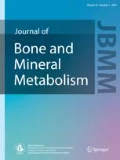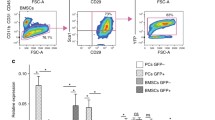Abstract
Fracture healing is a complex biological process involving the proliferation of mesenchymal progenitor cells, and chondrogenic, osteogenic, and angiogenic differentiation. The mechanisms underlying the proliferation and differentiation of mesenchymal progenitor cells remain unclear. Here, we demonstrate Dickkopf-related protein 3 (Dkk3) expression in periosteal cells using Dkk3–green fluorescent protein reporter mice. We found that proliferation of mesenchymal progenitor cells began in the periosteum, involving Dkk3-positive cell proliferation near the fracture site. In addition, Dkk3 was expressed in fibrocartilage cells together with smooth muscle α-actin and Col3.6 in the early phase of fracture healing as a cell marker of fibrocartilage cells. Dkk3 was not expressed in mature chondrogenic cells or osteogenic cells. Transient expression of Dkk3 disappeared in the late phase of fracture healing, except in the superficial periosteal area of fracture callus. The Dkk3 expression pattern differed in newly formed type IV collagen positive blood vessels and the related avascular tissue. This is the first report that shows Dkk3 expression in the periosteum at a resting state and in fibrocartilage cells during the fracture healing process, which was associated with smooth muscle α-actin and Col3.6 expression in mesenchymal progenitor cells. These fluorescent mesenchymal lineage cells may be useful for future studies to better understand fracture healing.







Similar content being viewed by others
References
Grcevic D, Pejda S, Matthews BG et al (2012) In vivo fate mapping identifies mesenchymal progenitor cells. Stem Cell 30:187–196
Kalajzic Z, Li H, Wang LP et al (2008) Use of an alpha-smooth muscle actin GFP reporter to identify an osteoprogenitor population. Bone 43:501–510
Krupnik VE, Sharp JD, Jiang C et al (1999) Functional and structural diversity of the human Dickkopf gene family. Gene 238:301–313
Bafico A, Liu G, Yaniv A, Gazit A, Aaronson SA (2001) Novel mechanism of Wnt signalling inhibition mediated by Dickkopf-1 interaction with LRP6/Arrow. Nat Cell Biol 3:683–686
Mao B, Wu W, Li Y et al (2001) LDL-receptor-related protein 6 is a receptor for Dickkopf proteins. Nature 411:321–325
Glinka A, Wu W, Delius H, Monaghan AP, Blumenstock C, Niehrs C (1998) Dickkopf-1 is a member of a new family of secreted proteins and functions in head induction. Nature 391:357–362
del Barco Barrantes I, Davidson G, Grone HJ, Westphal H, Niehrs C (2003) Dkk1 and noggin cooperate in mammalian head induction. Gene Dev 17:2239–2244
Mao B, Niehrs C (2003) Kremen2 modulates Dickkopf2 activity during Wnt/LRP6 signaling. Gene 302:179–183
Mao B, Wu W, Davidson G et al (2002) Kremen proteins are Dickkopf receptors that regulate Wnt/β-catenin signalling. Nature 417:664–667
Yamaguchi Y, Itami S, Watabe H et al (2004) Mesenchymal–epithelial interactions in the skin: increased expression of dickkopf1 by palmoplantar fibroblasts inhibits melanocyte growth and differentiation. J Cell Biol 165:275–285
Montero-Pedrazuela A, Bernal J, Guadano-Ferraz A (2003) Divergent expression of type 2 deiodinase and the putative thyroxine-binding protein p29, in rat brain, suggests that they are functionally unrelated proteins. Endocrinology 144:1045–1052
Sato S, Inoue T, Terada K et al (2007) Dkk3-Cre BAC transgenic mouse line: a tool for highly efficient gene deletion in retinal progenitor cells. Genesis 45:502–507
Kobayashi K, Ouchida M, Tsuji T et al (2002) Reduced expression of the REIC/Dkk-3 gene by promoter-hypermethylation in human tumor cells. Gene 282:151–158
Hsieh SY, Hsieh PS, Chiu CT, Chen WY (2004) Dickkopf-3/REIC functions as a suppressor gene of tumor growth. Oncogene 23:9183–9189
Sakaguchi M, Kataoka K, Abarzua F et al (2009) Overexpression of REIC/Dkk-3 in normal fibroblasts suppresses tumor growth via induction of interleukin-7. J Biol Chem 284:14236–14244
Barrantes Idel B, Montero-Pedrazuela A, Guadano-Ferraz A et al (2006) Generation and characterization of dickkopf3 mutant mice. Mol Cell Biol 26:2317–2326
Bilic-Curcic I, Kronenberg M, Jiang X et al (2005) Visualizing levels of osteoblast differentiation by a two-color promoter-GFP strategy: type I collagen-GFPcyan and osteocalcin-GFPtpz. Genesis 43:87–98
Yokota T, Kawakami Y, Nagai Y et al (2006) Bone marrow lacks a transplantable progenitor for smooth muscle type α-actin-expressing cells. Stem Cell 24:13–22
Chan LL, Huang J, Hagiwara Y, Aguila L, Rowe D (2014) Discriminating multiplexed GFP reporters in primary articular chondrocyte cultures using image cytometry. J Fluoresc 24:1041–1053
Bonnarens F, Einhorn TA (1984) Production of a standard closed fracture in laboratory animal bone. J Orthop Res 2:97–101
Dacic S, Kalajzic I, Visnjic D, Lichtler AC, Rowe DW (2001) Col1a1-driven transgenic markers of osteoblast lineage progression. J Bone Miner Res 16:1228–1236
Ushiku C, Adams DJ, Jiang X, Wang L, Rowe DW (2010) Long bone fracture repair in mice harboring GFP reporters for cells within the osteoblastic lineage. J Orthop Res 28:1338–1347
Bornstein P, Sage H (1980) Structurally distinct collagen types. Annu Rev Biochem 49:957–1003
Tavella S, Bellese G, Castagnola P et al (1997) Regulated expression of fibronectin, laminin and related integrin receptors during the early chondrocyte differentiation. J Cell Sci 110:2261–2270
Aslan H, Ravid-Amir O, Clancy BM et al (2006) Advanced molecular profiling in vivo detects novel function of dickkopf-3 in the regulation of bone formation. J Bone Miner Res 21:1935–1945
Acknowledgments
This study was supported by JSPS KAKENHI (25870039), the Department of Defense (DAMD W81XWH07-2-0085), and the National Institutes of Health (AR052374).
Author information
Authors and Affiliations
Corresponding author
Ethics declarations
Conflict of interest
The authors declare that they have no conflict of interest.
Electronic supplementary material
Below is the link to the electronic supplementary material.
774_2015_711_MOESM1_ESM.tif
Fig. S1 Fibrocartilage proliferation and Dkk3 green expression at day 7 after fracture. Left picture shows an image of safranin-O and hematoxylin staining, mature cartilage cells are positive for safranin-O red (arrow) (×10 magnification). Right picture shows Dkk3-green GFP image, Dkk3-green is not positive on the mature fibrocartilage cells, is expressed on the superficial area of mature fibrocartilage cells (arrow head) (×10 magnification). (TIFF 3417 kb)
About this article
Cite this article
Mori, Y., Adams, D., Hagiwara, Y. et al. Identification of a progenitor cell population destined to form fracture fibrocartilage callus in Dickkopf-related protein 3–green fluorescent protein reporter mice. J Bone Miner Metab 34, 606–614 (2016). https://doi.org/10.1007/s00774-015-0711-1
Received:
Accepted:
Published:
Issue Date:
DOI: https://doi.org/10.1007/s00774-015-0711-1




